Montana’s winter transforms the landscape and reveals the resilience and beauty of its wildlife. The state is home to many animals, from creatures scared of the snow to those that thrive in the cold. This diversity is proof of nature’s adaptability and the unique habitats across the state.
We will explore how animals classify based on their relationship with winter. The journey includes encounters with iconic Montana winter wildlife, revealing their survival methods. Whether it’s bison navigating icy conditions or otters using snow for insulation, each story is a triumph of nature.
- Related article: Montana Wildlife Adventures
Are you curious about how beavers cope with frozen ponds or where to spot a moose in winter? Our guide is filled with practical tips and fascinating facts. It’s an invitation to witness nature’s wonders in Montana’s snow-covered landscapes, offering a deeper connection to the state’s wild heart.
7 Key Takeaways on Montana Winter Animals
- Montana’s winter wildlife is incredibly diverse, with animals that love snow and those that avoid it.
- Common winter wildlife in Montana, from bison to birds, have fascinating survival strategies for the cold months.
- Hibernation is a key survival tool for many of Montana’s animals, allowing them to conserve energy and endure winter’s scarcity.
- Many other mammals in Montana do not hibernate but survive by digging underground.
- Yellowstone and Glacier National Parks offer breathtaking views of Montana’s winter wildlife.
- Tips for winter wildlife watching include dressing warmly and respecting animal habitats.
- Identifying animal track patterns in the snow adds a new dimension to observing wildlife from a distance.
What You Need to Know About Montana’s Winter Animals
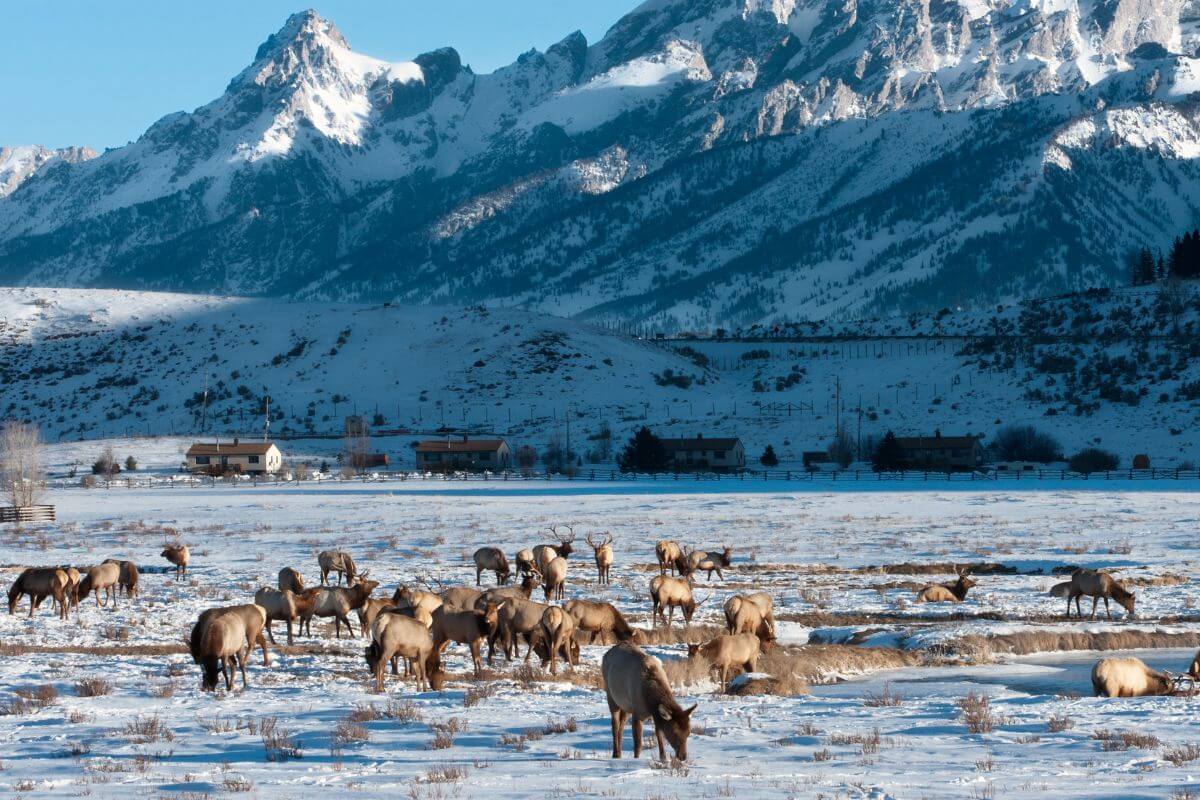
Montana’s winter turns the landscape into a quiet, snow-covered wonderland. The state is home to various animals uniquely adapted to the cold. These creatures survive and thrive in the frigid temperatures, showcasing the resilience and beauty of nature. Let’s take a closer look at Montana’s fascinating winter wildlife.
How Are Winter Animals in Montana Classified?
Winter presents unique challenges for all living creatures, and how they deal with the cold can be quite revealing. In particular, animals have come up with smart ways to handle the chill. These strategies have led to the classification of winter animals based on how they’ve adapted to their surroundings.
Formozov developed a classification system that’s still widely used today. This system helps us see just how well animals have adapted to winter. Here’s a breakdown of the classifications:
- Snow Fearers (Chionophobes) – Snow fearers are not fans of snow and usually stay in warmer areas.
- Snow Toleraters (Chioneuphores) – Snow toleraters do okay in the snow without needing special gear. They often find cozy spots under the snow or in small, warm areas.
- Snow Lovers (Chionophiles) – Snow lovers are animals that really embrace the cold. Their specific adaptations make winter life not just bearable but enjoyable.
Here’s a handy table to give you a clear picture of these animal groups:
| Classification | Examples of Winter Animals |
|---|---|
| Snow Fearers | Black Vulture, Ocelot, Opossum |
| Snow Toleraters | Shrew, Red Fox, Vole, Elk |
| Snow Lovers | Snowshoe Hare, Lemming, Ptarmigan, Weasel |
These classifications show us the diversity of animal responses to winter. This knowledge deepens our appreciation for nature and helps us see the interconnectedness of all life in the face of environmental challenges.
What Types of Wildlife Can You See in Montana During Winter?

Montana’s winter landscapes are home to a remarkable array of wildlife specially adapted to thrive in the cold. Watch for these incredible creatures as you explore the state in winter. From bison to birds, each animal has its own unique way of dealing with the chill.
Some of the wildlife you can see in Montana during winter:
- Bison – These massive creatures are built to handle the cold. With a thick, woolly coat and hard hooves, bison can endure temperatures that would be unbearable for many others. They move to lower ground in the northern part of Yellowstone during winter.
- Elk – Elk are on the move when winter comes. They quickly search for open, snowy areas where they can find food. Their survival method involves burning many calories to navigate through deep snow. The Blackfoot-Clearwater Wildlife Management Area near Seeley Lake is a top elk winter habitat in western Montana.
- Beaver – Beavers stay warm with the help of their fur and a layer of fat despite the icy waters of their ponds. Their winter homes, created behind the dams they build, provide a safe haven. You can find beavers during winter on the Gallatin River.
- Bighorn Sheep – Heavy snow forces bighorn sheep down to lower, more accessible elevations. They prefer steep and canyon-filled habitats in Yellowstone, which makes them a bit easier to spot in winter.
- Birds – While many birds have flown south, rough-legged hawks and snowy owls head to Montana in winter. Their incredible feather insulation keeps them warm as they hunt for food. To spot these hawks, head to the Mission Valley, one of the country’s largest groups of wintering rough-legged hawks.
- Coyote, Long-tailed Weasel, Red Fox – These predators use thick fur and clever hunting techniques to survive, including scenting and listening for small rodents under the snow. It’s a wonderful experience to spot red foxes in the wilderness of Yellowstone during winter.
- Moose – Moose move through snow more easily than elk with their specially adapted joints. This allows them to find food and avoid deep, tiring paths. One of the best places to find moose is in the Gallatin Mountain Range.
- Mountain Goat – Mountain goats are the largest mammals that stay active in the high and snowy regions all year, especially at Glacier National Park. They sport heavy wool undercoats and long, hollow guard hairs.
- River Otter – After swimming in icy waters, river otters use snow to refresh their fur. It’s designed to trap air and keep them warm. Winter is the best time to see them at places like the Grizzly & Wolf Discovery Center.
- Wolf – Wolves primarily hunt elk in winter, targeting the weaker individuals to conserve energy. This strategy helps them survive the cold months. To see wolves in Montana during this time, there is no better place than in Yellowstone.
Each of these animals plays a vital role in Montana’s ecosystem, showing just how diverse and resilient wildlife can be in the face of winter. This guide to winter wildlife will enrich your experience as you venture out into the snow, offering a glimpse into the lives of those who call Montana’s winter home.
How Does Wildlife Survive Montana’s Brutal Winters?
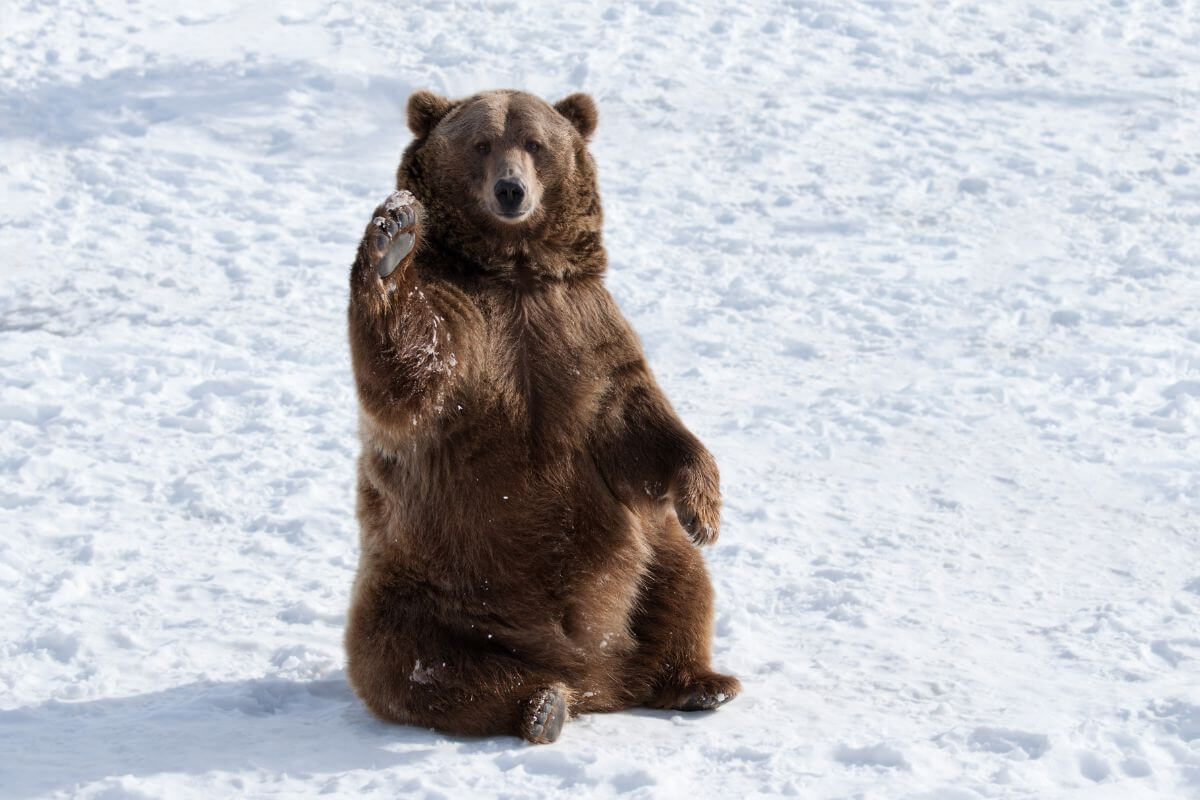
Montana’s winter is no joke, but its wildlife has some incredible tricks up its sleeves to survive and thrive. Many animals here have mastered the art of hibernation, a superpower that lets them slow down their bodies and save energy.
Some animals in Montana that hibernate during winter:
- Bears – Before winter hits, grizzly and black bears have a feast. This eating spree, called hyperphagia, loads them up with the extra fat they need. Their metabolism changes a lot, getting them ready for a long nap. While not a true hibernation, this dormancy period helps them survive on limited resources. During this time, visitors are less likely to encounter bears on trails, making hiking safer.
- Ground Squirrels – These tiny creatures are big on hibernation. Ground squirrels go from breathing 200 times a minute to almost not at all. Their heartbeats slow down massively, too, making them the ultimate energy savers. Visitors might notice fewer ground squirrels scampering around and causing trouble at homes at this time.
- Bats – Hibernating bats drop their heart rates significantly, from 1,200 beats per minute to just a few. This allows them to wait out the winter without their usual meals of flying insects. This reduces the chance of seeing bats in their usual habitats, like caves or old buildings.
Some wildlife has adapted to the cold:
- Mice and Voles – Mice and voles create cozy homes under the snow instead of hibernating. These small mammals take advantage of the earth’s natural warmth and the insulating properties of the snowpack. They huddle together for extra warmth during extreme cold.
- Other Mammals – Animals like marmots and badgers have their own strategy. They dig deep into the ground, below where it freezes, to find a place that’s always a bit warmer.
- Frogs – Some frog species in Montana have a chilling ability to survive being partially frozen. They let up to 65% of their body freeze and still keep hopping.
These creatures showcase the incredible adaptations of wildlife to Montana’s winters, from full-on hibernation to innovative ways of staying warm. Each is a testament to the marvels of nature.
Where to See Winter Wildlife in Montana
Winter in Montana transforms the landscape into a wonderland, offering unique opportunities to witness the state’s wildlife in a new light. Knowing where to go greatly enhances the chances of spotting these creatures.
Yellowstone National Park – Winter Bighorn Sheep Display
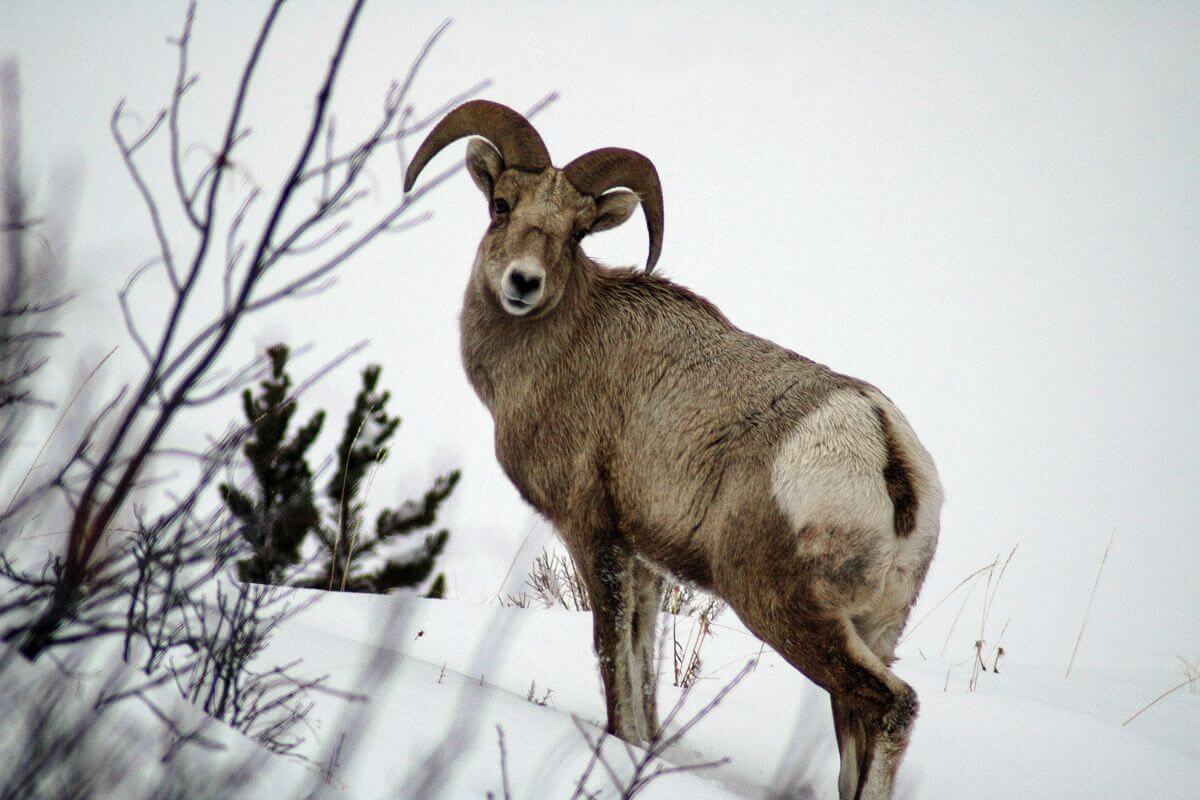
Yellowstone National Park is a top destination for winter wildlife. It boasts the largest concentration of wildlife in the lower 48 states. Yellowstone transforms into a magical landscape in winter, with steam and boiling water bursting from natural cauldrons against an ice-covered backdrop.
As you explore the park, you’ll see snow-dusted bison, their breath hanging in the cold air as they move through the white drifts. Foxes and coyotes are out too, hunting in the deep snow. And don’t forget the gray wolves, their howls under the frozen moon adding to the park’s enchanting atmosphere.
December is the time for bighorn sheep to rut near the park’s north entrance. It’s a sight – large groups of rams clashing for mates. You can witness this natural spectacle off Highway 89 between Gardiner and Mammoth Hot Springs.
The park’s only open route in winter runs from Gardiner to Cooke City, passing through the Lamar Valley. This valley is a treasure trove of wildlife. Among the fresh snow-covered vistas, you can spot bison, black bears, elk, mule deer, and more.
Yellowstone in winter is more than just a snowy landscape. It’s where life flourishes, the cold brings a quiet beauty to the land, and you can witness nature’s wonders up close.
Glacier National Park – Winter White-Tailed Deer Encounters
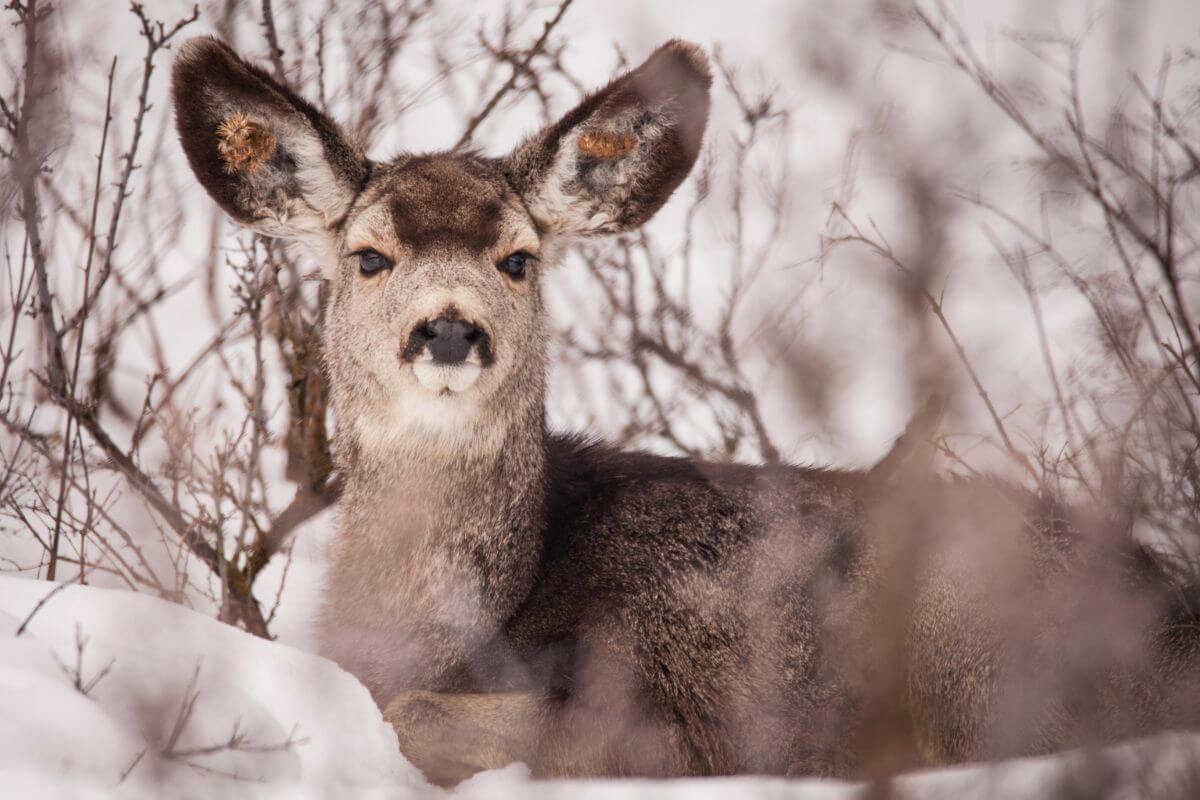
Winter transforms Glacier National Park into a snow-covered haven from November through March. This period is the quietest and longest season in the park, characterized by substantial snowfall. The landscape becomes a perfect canvas for the park’s excellent wildlife viewing.
Glacier National Park is home to a remarkable diversity of wildlife, with 71 species of mammals. While many visitors hope to glimpse iconic animals like moose, elk, and bighorn sheep, the park also shelters more elusive creatures such as mountain lions, lynx, and wolverines.
Although these larger species are rarely seen, the park’s winter wonderland offers a more frequent sighting of white-tailed deer and various bird species that spend their winters there. Visitors might spot waterfowl on Lake McDonald and the ever-present ravens.
Navigating the park during winter can be challenging, as most roads are closed. However, the famous Going-to-the-Sun Road, stretching from West Glacier to Lake McDonald Lodge, remains open year-round. This allows breathtaking views and, when weather permits, safe passage.
What Are Tips for Winter Wildlife Watching in Montana?
Winter in Montana transforms the landscape into a quiet, snow-covered haven, perfect for spotting wildlife. The blanket of snow makes it easier to see animals as they move across the hills and valleys.
This cold season also sees many animals shifting to lower elevations with less snow. The roads are more accessible, offering a unique opportunity for wildlife viewing.
When you head out to watch wildlife during winter in Montana, remember these essential tips:
- Dress for the Weather – The first rule is to bundle up. Wear warm boots, mittens, and many layers to stay comfortable in the cold.
- Keep Your Distance – Always observe from afar. Using binoculars or a spotting scope allows for a close look without intruding on the animals’ space.
- Make Your Presence Known – Announce your presence by talking or making noise as you walk to avoid surprising wildlife.
- Stay on Designated Paths – Following marked trails keeps you safe and protects the animals’ habitats.
- Be Bear Aware – Bears can wake up even in winter. Carry bear spray and know how to use it in bear country.
Watching wildlife tracks in the snow can tell you much about the creatures that made them. Here are the main track patterns to look out for:
| Track Patterns | Description | Examples |
|---|---|---|
| Hoppers | Hoppers move by hopping and leaving clumps of four tracks. | Rabbits, Hares, Squirrels |
| Bounders | Bounders have long bodies and short legs. They move with backtracks right behind the front tracks like an accordion. | Weasels, Otters, Wolverines |
| Waddlers | Waddlers have large bodies and short legs. They lift both feet on one side before the other, leaving specific tracks. | Bears, Porcupines, Raccoons |
| Striders | Striders lift opposite front and back feet simultaneously, leaving a straight line of single tracks. | Cats, Canines, Hooved Animals |
These tips and track patterns will enhance your wildlife-watching experience, making it both safe and insightful. Enjoy the beauty and serenity of Montana’s winter landscape as you discover its amazing wildlife.
Montana Winter Animals Final Thoughts
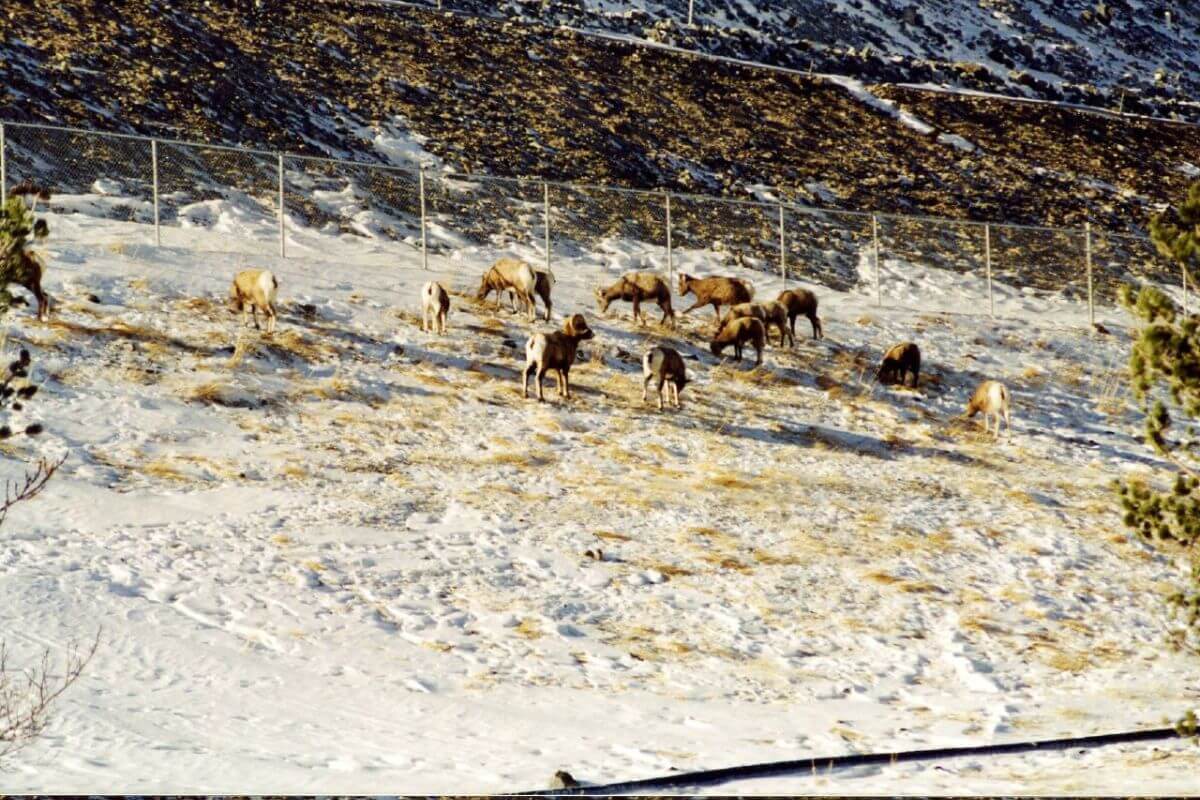
Montana’s winter is a time of quiet beauty, where the landscape is peaceful and teeming with life. From bison to birds, the state’s wildlife has incredible stories of survival. This season offers a unique view of nature, showing us how animals have adapted to the cold in both practical and awe-inspiring ways.
As we witness Montana’s winter animals, we’re reminded of the importance of respectful observation. Dressing warmly, keeping a safe distance, and making our presence known all contribute to a positive wildlife-watching experience.
Knowing the best places to look, like Yellowstone and Glacier National Parks, can lead to unforgettable encounters with creatures big and small. This guide and tips on track patterns in the snow aim to enrich your connection with nature, highlighting the wonder of Montana’s winter wildlife.
Montana Winter Animals FAQs
1. How Cold Is Montana in Winter?
Montana winters can be very cold, often dropping well below freezing. Subzero temperatures are common, especially in the northern and mountainous regions of the state. Heavy snowfall is also normal, making the cold conditions even more challenging.
2. How to Survive a Montana Winter?
During a Montana winter, it is important to wear warm layers. This includes insulated outerwear, hats, gloves, and waterproof boots. Stay updated on weather forecasts and road conditions to avoid traveling during severe winter storms.
3. What Animal Is Common in Montana?
The American Bison, also known as the buffalo, is a common animal in Montana. They can be seen in various parts of the state, especially in national parks and wildlife refuges.
4. What Animal Is Most Active in Winter?
Deer are often active in Montana during winter. They can be seen looking for food, especially at dawn and dusk when they are most active.
5. Is Montana Mostly Hot or Cold?
Montana has a wide range of temperatures. It tends to be colder, especially in the winter months. Summers can be warm, but the state’s northern location and higher elevations contribute to cooler temperatures compared to more southern regions of the United States.
Witness Montana’s diverse wonders in the articles below:
- Learn About Montana’s Squirrels
- Montana’s Winter Bird Species
- Facts About Wolves in Montana
- Guide to Ducks in Montana

